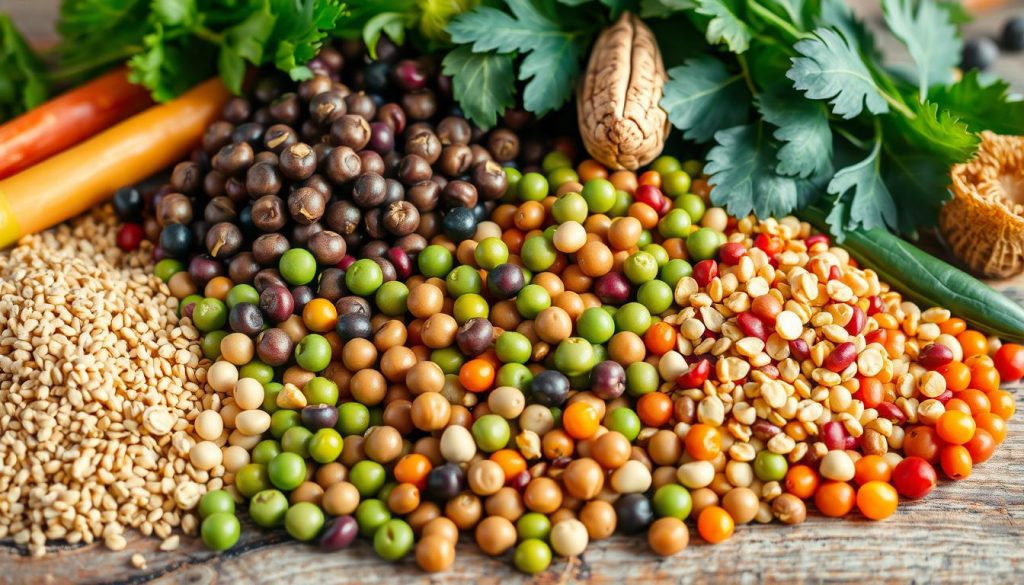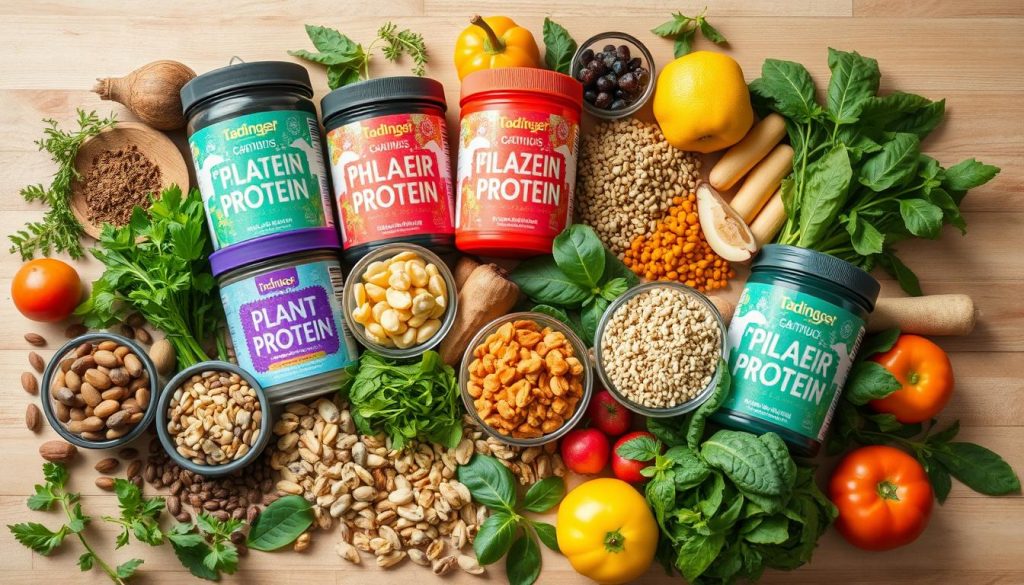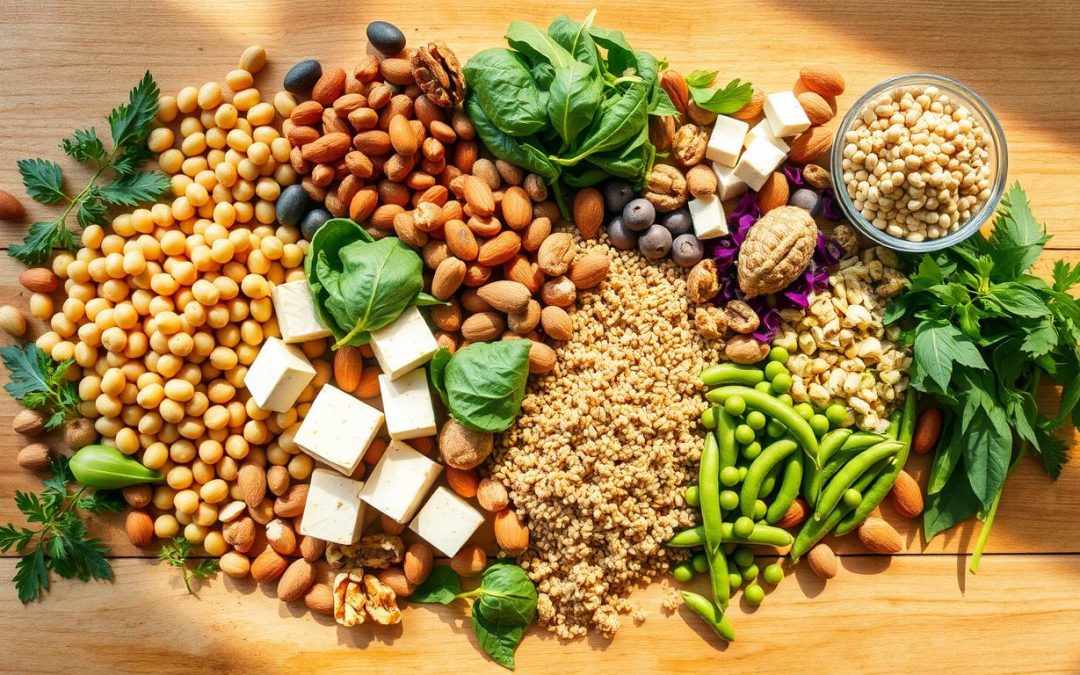Can a plant-based diet give us enough protein for a healthy life? With 12 percent of Americans now eating plant-based, it’s key to look into the benefits and choices. A plant-based protein sources review helps us see the high protein, fiber, vitamins, and minerals in vegan options.
We’ll explore plant-based protein sources, their benefits, types, and examples. This includes legumes, nuts and seeds, and whole grains. With 31 percent of Americans eating more whole-plant foods1, the need for plant-based diets is rising. It’s important to check out the different vegan protein options.
Table of Contents
Key Takeaways
- Plant-based protein sources can provide a range of protein content, such as peas, chickpeas, and black-eyed peas2.
- Plant-based sources provide 57% of the total dietary protein supply globally3.
- Switching to plant-based proteins can cut down greenhouse gas emissions and help the environment2.
- A 2019 study showed that going vegan can cut personal greenhouse gas emissions by 50 percent1.
- Common beans are the main vegetable protein source in developing nations3.
- Plant-based protein sources review is essential in understanding the various options available, including legumes, nuts and seeds, and whole grains.
- Quinoa, a whole grain, provides 8.4 g of protein per cooked cup2.
Introduction to Plant-Based Proteins
More people are choosing plant-based diets for their health and the planet. Plant-based proteins come from plants like legumes, nuts, and seeds, and whole grains. They are packed with protein, fiber, and vitamins and minerals4.
Looking for the best plant-based protein sources? Legumes like lentils, chickpeas, and beans are full of protein and fiber. Nuts and seeds, such as almonds and chia seeds, are also great for protein and healthy fats. Whole grains like quinoa and brown rice add protein and fiber to our meals5.
A study in the Journal of Food Science shows plant-based proteins can lower disease risk. With more people wanting plant-based diets, knowing the different types and their benefits is key. We can make better choices by comparing plant-based proteins and adding them to our meals6.
- Legumes: lentils, chickpeas, beans
- Nuts and seeds: almonds, chia seeds, hemp seeds
- Whole grains: quinoa, brown rice, whole wheat
Adding these plant-based proteins to our diets can make our meals balanced and sustainable. Whether you’re searching for best plant-based protein sources or comparing plant proteins, there are many options4.
The Importance of Protein in Your Diet
Protein is key for our bodies. It helps build and fix tissues, makes enzymes and hormones, and keeps fluids balanced7. Knowing about complete plant proteins is vital in a non-dairy protein review. Adults need at least 0.8 grams of protein per kilogram of body weight each day7.
Eating a healthy plant-based diet can lower stroke risk by 10%8. People on plant-based diets have less type 2 diabetes than those eating animal protein8. To get enough protein, we can eat legumes, nuts, and seeds. Here are some examples:
- Legumes: beans, lentils, and peas
- Nuts and seeds: almonds, chia seeds, and pumpkin seeds
- Whole grains: quinoa, oats, and brown rice
Exploring plant-based proteins is important. A well-planned diet gives us all the nutrients we need for health. By eating a variety of complete plant proteins, we stay healthy and lower disease risk8.
| Food | Protein Content |
|---|---|
| 1 cup cooked lentils | 18g |
| 1 cup cooked quinoa | 8g |
| 1 ounce almonds | 6g |
Top Plant-Based Protein Sources
Looking for the best protein sources is key, even more so for athletes. Plant-based proteins offer many benefits, like high protein, fiber, and vitamins. It’s best to start with whole foods like legumes, nuts, seeds, and grains.
Legumes, like beans, lentils, and peas, are packed with protein and fiber. Lentils have 18 g of protein per cup9. Beans, such as kidney, black, pinto, and chickpeas, have about 15 g per cup9. Nuts and seeds, like almonds and chia seeds, are also protein-rich. Almonds have 9 g of protein per 1.5 ounces10, and hemp seeds have 9 g in 3 tablespoons10.
Whole grains, like quinoa, oats, and brown rice, are full of nutrients. Quinoa has 8 g of protein per cup10. Oats have 5 g of protein per cup10. These foods are easy to add to meals, helping athletes meet their protein needs.
Legumes: Beans, Lentils, and Peas
- Lentils: 18 g of protein per cooked cup9
- Beans: 15 g of protein per cooked cup9
- Peas: nearly 9 g of protein per cooked cup9
Nuts and Seeds: Small but Mighty
- Almonds: 9 g of protein per 1.5 ounces10
- Hemp seeds: 9 g of protein in a 3-tablespoon serving10
- Chia seeds: 2 g of protein per tablespoon11
Whole Grains: Quinoa, Oats, and Brown Rice
- Quinoa: 8 g of protein per cooked cup10
- Oats: 5 g of protein per 1 cup10
- Brown rice: 2 g of protein per 1 cup
Exploring the World of Legumes
Legumes are packed with protein, fiber, and vitamins and minerals. They are perfect for those who follow plant-based diets12. They help lower the risk of heart disease, type 2 diabetes, and some cancers12. Legumes are a tasty and versatile way to get protein in your diet.
Kidney beans, chickpeas, and lentils are among the most loved legumes. They are full of protein and fiber. Kidney beans are great in soups, chickpeas are perfect for salads, and lentils are quick and nutritious12.
Legumes are also good for your health. Eating them often can lower the risk of heart disease and type 2 diabetes13. They are also a good source of essential amino acids, making them great for vegans13.

The table below shows the nutritional benefits of some popular legumes:
| Legume | Protein Content | Fiber Content |
|---|---|---|
| Kidney Beans | 15g per 100g | 8g per 100g |
| Chickpeas | 19g per 100g | 12g per 100g |
| Lentils | 18g per 100g | 10g per 100g |
In conclusion, legumes are a great choice for plant-based diets. They offer many health benefits and can be used in many dishes12.
The Power of Nuts and Seeds
Nuts and seeds are packed with protein, healthy fats, and vitamins. They are perfect for those who follow a plant-based diet14. Eating them regularly can help lower heart disease and type 2 diabetes risks15. They also improve blood pressure and cholesterol levels16.
Almonds, chia seeds, and pumpkin seeds are top picks for plant-based protein. Almonds are good for the heart. Chia seeds are small but full of fiber and protein. Pumpkin seeds are rich in nutrients, making them great for many dishes.
When comparing plant proteins, nuts and seeds stand out. They offer up to 10 grams of protein per ounce14. They also have healthy fats that can lower cholesterol and heart disease risk15. Nuts and seeds are a smart choice for those seeking plant-based protein sources.
| Nut/Seed | Protein Content (per ounce) | Healthy Fats |
|---|---|---|
| Almonds | 6 grams | Monounsaturated and polyunsaturated fats |
| Chia Seeds | 5 grams | Omega-3 fatty acids |
| Pumpkin Seeds | 7 grams | Monounsaturated and polyunsaturated fats |
In conclusion, nuts and seeds are a fantastic choice for plant-based protein. They are nutritious and offer many health benefits. Adding them to your diet can boost your health and lower disease risks16.
Whole Grains as Protein Staple
Whole grains are key in our diet, important for non-dairy protein and plant-based nutrition. They are packed with protein, fiber, and vitamins and minerals. This makes them great for those who don’t eat meat17. About 41% of global grains feed people, and whole grains help with protein and fight climate change17.
A non-dairy protein review shows whole grains like quinoa and buckwheat are full of protein. Quinoa has 8 grams of protein per cup cooked18. Buckwheat is gluten-free and rich in protein and fiber. Here’s a table of protein in different whole grains:
| Whole Grain | Protein Content (per cup cooked) |
|---|---|
| Quinoa | 8 grams18 |
| Wild Rice | 6.5 grams18 |
| Amaranth | 9 grams18 |
Exploring whole grains, we find quinoa is a complete plant protein. It has all nine essential amino acids. This makes it a great choice for a healthy meal. Whole grains also lower heart disease, type 2 diabetes, and some cancers risk19.
In summary, whole grains are essential for a plant-based diet. They offer protein, fiber, and vitamins and minerals. Choosing whole grains like quinoa and buckwheat ensures we get the nutrients we need for health. They are perfect for a non-dairy protein review and complete plant proteins17.
Incorporating Plant-Based Proteins in Meals
We can easily add plant-based proteins to our meals. They are a great choice for a healthy and easy diet20. For athletes, plant-based protein for athletes helps boost energy and grow muscles. Try overnight oats with nuts and seeds for a protein-packed breakfast21.
Legume-based dishes like lentil soup or chickpea salad are perfect for lunch and dinner20. They are not only high in protein but also full of fiber and antioxidants. For a quick snack, energy balls or trail mix with nuts and dried fruits are great. They offer a convenient way to get top plant protein supplements while on the move22.
Some popular plant-based protein sources include:
- Almonds
- Black beans
- Lentils
- Peanuts
- Soybeans
These foods can be easily added to various meals. They provide a lot of protein and other important nutrients21.
Choosing plant-based proteins can improve our health and help the environment. It reduces greenhouse gas emissions and saves natural resources22. With a bit of creativity, we can make plant-based proteins a key part of our diets. We’ll enjoy the many benefits they offer20.
Plant-Based Protein Supplements
Looking for plant-based protein sources review options that fit into our daily lives? Vegan protein options are perfect for those following a plant-based diet. They come in forms like protein powders and bars, making it easy to increase your protein intake23.
Protein powders are a hit for their high protein and ease of use. You can find pea, hemp, rice, and soy protein powders23. Bars are great for those always on the move. With about 20 to 22 grams of protein per serving24, picking the right supplement is key.
When picking a plant-based protein supplement, think about protein content, where the ingredients come from, and nutritional benefits. A good protein powder should have at least 20-30 grams of protein and 6-15 grams of essential amino acids per serving25. Also, choose ones with less added sugars and calories. With many choices, it’s important to read reviews and research to find the best plant-based protein sources review for you.

Adding plant-based protein supplements to your diet can help increase your protein intake and support your health. With the right supplement, you can enjoy the perks of vegan protein options and keep your diet balanced23.
Common Misconceptions About Plant-Based Proteins
Many people think plant proteins are not good enough or complete. But, this is a myth. Plant proteins can give you all the amino acids you need for a healthy diet. With a bit of planning, you can make sure plant proteins are part of a balanced diet.
A plant protein comparison shows that many plant foods can give you all the amino acids you need. For example, eating legumes with whole grains gives you all the essential amino acids. Also, foods like quinoa and chia seeds are complete proteins by themselves26.
The best plant-based protein sources include legumes, nuts, and seeds. These foods are not just high in protein but also full of fiber, vitamins, and minerals. When picking plant-based proteins, think about their quality and how well your body can use them27. By making smart choices, you can get enough protein from plants to keep you healthy.
In conclusion, plant proteins are a great choice for a healthy diet. Knowing about different plant proteins and how to mix them helps you get enough protein. With the right knowledge, plant proteins can help you stay healthy and well26.
Conclusion: Embracing Plant-Based Proteins
Exploring plant-based protein sources shows the health benefits of a plant-powered diet28. Eating more plant proteins can lower heart disease, type 2 diabetes, and some cancers risks28. Now, with more people wanting sustainable and ethical food, it’s a great time to try plant-based protein-rich options.
Legumes like beans, lentils, and chickpeas are full of nutrients. Nuts and seeds, and whole grains like quinoa and buckwheat, also offer a lot of protein2829. Adding these to your diet means you can get enough protein and enjoy tasty meals.
We encourage you to try plant-based proteins in your daily meals. Start with a plant-based breakfast, have a protein-rich lunch, or enjoy a plant-based dinner2930. There’s a lot to discover in the world of plant-based cooking. Let’s start this exciting journey together and enjoy a healthier diet.
FAQ
What are plant-based proteins?
Why are plant-based proteins important for a healthy diet?
What are the top plant-based protein sources?
Are plant-based proteins incomplete or of low quality?
How can I incorporate plant-based proteins into my meals?
What are some plant-based protein supplements?
Source Links
- Everything You Need to Know About Plant-Based Protein – https://www.healthline.com/nutrition/plant-based-protein-the-best-the-worst-and-everything-in-between
- Do You Know These 20 Vegan and Vegetarian Protein Sources? – https://www.health.com/food/19-best-vegetarian-and-vegan-protein-sources
- Frontiers | Sustaining Protein Nutrition Through Plant-Based Foods – https://www.frontiersin.org/journals/nutrition/articles/10.3389/fnut.2021.772573/full
- Plant Proteins: Assessing Their Nutritional Quality and Effects on Health and Physical Function – https://pmc.ncbi.nlm.nih.gov/articles/PMC7760812/
- Animal- and Plant-Based Protein Sources: A Scoping Review of Human Health Outcomes and Environmental Impact – https://www.mdpi.com/2072-6643/14/23/5115
- An Introduction to Plant-Based Protein – https://plantfusion.com/blogs/plantfusion-lifestyle/an-introduction-to-plant-based-protein?srsltid=AfmBOoo4nHoCkneRXYHPHpxfHDuxaw8YHIJ5CbK3wmfFDmWe4i-Pc8Ii
- Protein – https://nutritionsource.hsph.harvard.edu/what-should-you-eat/protein/
- The Difference Between Animal Protein and Plant Protein – https://www.webmd.com/diet/difference-between-animal-protein-plant-protein
- The 18 Best Protein Sources for Vegans and Vegetarians – https://www.healthline.com/nutrition/protein-for-vegans-vegetarians
- The 10 Best Vegan Protein Sources – https://www.eatingwell.com/article/291111/the-10-best-vegan-protein-sources/
- 15 best plant-based protein foods – https://www.medicalnewstoday.com/articles/321474
- Legumes—A Comprehensive Exploration of Global Food-Based Dietary Guidelines and Consumption – https://pmc.ncbi.nlm.nih.gov/articles/PMC9370574/
- Animal- and Plant-Based Protein Sources: A Scoping Review of Human Health Outcomes and Environmental Impact – https://pmc.ncbi.nlm.nih.gov/articles/PMC9741334/
- The Health Benefits of Nuts and Seeds | Plant Based Health Professionals UK – https://plantbasedhealthprofessionals.com/the-health-benefits-of-nuts-and-seeds
- For Health, More Nuts, Beans and Whole Grains (Published 2023) – https://www.nytimes.com/2023/11/15/well/eat/plant-based-diet-nuts-beans-grains.html
- Consumption of Nuts and Seeds and Health Outcomes Including Cardiovascular Disease, Diabetes and Metabolic Disease, Cancer, and Mortality: An Umbrella Review – https://pmc.ncbi.nlm.nih.gov/articles/PMC9776667/
- Grains – a major source of sustainable protein for health – https://pmc.ncbi.nlm.nih.gov/articles/PMC9086769/
- 6 High-Protein Grains to Add to Your Pantry, According to a Dietitian – https://www.eatingwell.com/article/8049010/high-protein-grains-to-add-to-your-pantry/
- Whole Grains – https://nutritionsource.hsph.harvard.edu/what-should-you-eat/whole-grains/
- A brief review of the science behind the design of healthy and sustainable plant-based foods – npj Science of Food – https://www.nature.com/articles/s41538-021-00099-y
- 3 easy ways to pack protein into your plant-based diet – https://healthy.kaiserpermanente.org/colorado/health-wellness/healtharticle.3-ways-to-add-protein-into-plant-based-diet
- Current challenges of alternative proteins as future foods – npj Science of Food – https://www.nature.com/articles/s41538-024-00291-w
- Do Vegan Protein Powders Really Work? Our Experts Weigh-In and Give Your Their Top Picks – https://www.health.com/nutrition/best-vegan-protein-powder
- What Is the Best Vegan Protein Powder, and by “Best,” I Mean Tastiest? – https://www.bonappetit.com/story/best-vegan-protein-powder?srsltid=AfmBOoomdKijnzIl4WCNa3uSIhyi8YerTuXpxRZVjpFprs-QfBP7HJMj
- Plant-Based Protein vs. Whey Protein: Which Is Better? – https://www.healthline.com/nutrition/whey-vs-plant-protein
- Common questions and misconceptions about protein supplementation: what does the scientific evidence really show? – https://pmc.ncbi.nlm.nih.gov/articles/PMC11022925/
- 6 Common Myths About Plant-Based Protein: Debunked – https://www.ironvegan.ca/blogs/blogs/6-common-myths-about-plant-based-protein-debunked?srsltid=AfmBOor72G2XPo41AK4e7-3_kx8a2dFPs0Dia-lhPgx6mvWCkNBPjGSa
- Plant-based proteins as a food source and plant growth biostimulants – Discover Food – https://link.springer.com/article/10.1007/s44187-024-00161-0
- Perspective: Plant-Based Meat Alternatives Can Help Facilitate and Maintain a Lower Animal to Plant Protein Intake Ratio – https://pmc.ncbi.nlm.nih.gov/articles/PMC10201680/
- Embracing a plant-based diet – https://news.stanford.edu/stories/2021/05/embracing-plant-based-diet

